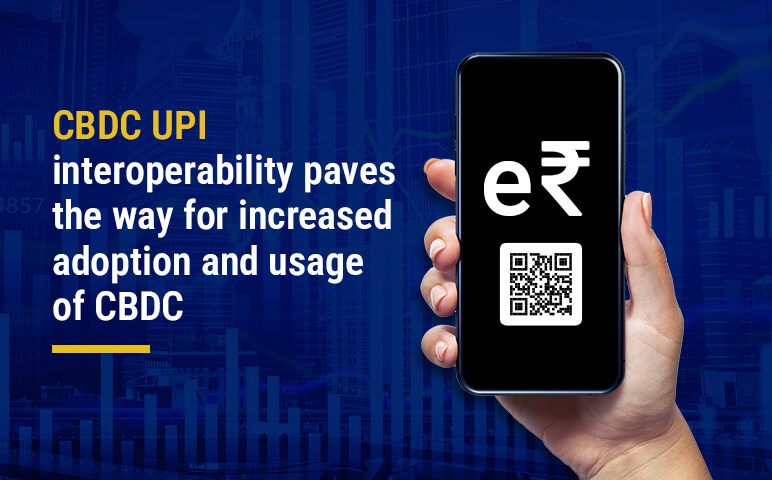Central Bank Digital Currencies (CBDCs) have gained prominence in recent years as governments and central banks seek to modernize financial systems and address challenges posed by traditional payment methods. CBDCs are digital representations of a country’s fiat currency, issued and regulated by the central bank. With the rise of digital transactions and the growing demand for more efficient and secure payment solutions, CBDCs have emerged as a transformative force in the global financial landscape.
Why is CBDC UPI interoperability important?
One of the key developments within the realm of CBDCs is the concept of CBDC UPI interoperability. This refers to the seamless integration between CBDCs and the Unified Payments Interface (UPI) framework, a real-time payment system developed by the National Payments Corporation of India (NPCI). UPI has played a pivotal role in revolutionizing digital payments in India, offering users a convenient and secure platform for transferring funds. The interoperability between CBDCs and UPI holds immense significance as it bridges the gap between traditional banking systems and digital payment platforms, enabling users to transact seamlessly across various channels.
How CBDC UPI interoperability works:
Initially, when CBDC was launched, it operated as an independent system with its own QR standards. Merchants had to register separately for CBDC and present separate QR codes for CBDC and UPI customers to scan and pay. This setup posed challenges for banks, requiring them to onboard the same merchant under two systems, and created operational hurdles for merchants managing multiple QR codes. However, with the introduction of CBDC UPI interoperability, this scenario has evolved. Now, users can seamlessly conduct transactions using CBDCs through the existing UPI infrastructure. This integration eliminates the need for separate QR codes and simplifies payment acceptance for merchants. By leveraging the UPI framework, CBDC UPI interoperability streamlines transactions, offering users a wide range of payment options while reducing operational complexities for both banks and merchants.
Behind the scenes, robust security measures, including blockchain technology and cryptographic protocols, ensure the integrity and confidentiality of transactions, safeguarding against potential threats and unauthorized access. Overall, CBDC UPI interoperability offers users greater flexibility, convenience, and security in their digital payment experiences, driving forward financial inclusion and innovation in the digital economy.
How does it benefit merchants?
Simplified payment acceptance: Merchants now only need to display one QR code to accept payments from both UPI and CBDC users. Thus eliminating the need for multiple QR codes or payment terminals, reducing complexity and overall costs.
Increased customer base: Merchants who accept CBDC payments can also have access to a new pool of potential clients who choose to pay in digital Rupees. This might be especially important with increased adoption of CBDC.
Faster transactions: UPI transactions are known for their speed and efficiency. Interoperability with CBDC should ensure a similarly smooth and quick payment experience for both customers and merchants.
Reduced operational costs: Streamlining payment acceptance with a single QR code can potentially reduce operational costs associated with managing multiple payment methods.
How does it benefit customers?
Greater Convenience: Customers benefit from the convenience of using a single QR code for various transactions, eliminating the need to juggle between different apps or platforms for UPI and CBDC payments.
Wider acceptance: With CBDC UPI interoperability, customers can use their CBDC wallets to pay at a wider range of merchants who already accept UPI payments, thanks to the interoperable QR code system.
Financial inclusion: The integration of CBDCs with UPI has the potential to promote financial inclusion by making CBDC more accessible to people in remote areas who may already be familiar with UPI.
Simplified Fund Transfers: CBDC UPI interoperability simplifies fund transfers for customers, enabling them to send money to family and friends with ease. This simplicity eliminates barriers to sending and receiving funds, promoting financial inclusion and connectivity.
Enhanced Security: The integration of CBDCs with UPI ensures a high level of security and transparency in digital transactions. Customers can trust that their payments are secure and protected, enhancing confidence in the digital payment ecosystem.
Increasing CBDC adoption through interoperability:
The interoperability between CBDCs and UPI serves as a catalyst for increased adoption of digital currencies. By integrating CBDCs with existing payment infrastructures like UPI, central banks can promote the widespread use of digital currencies among the general public. Interoperability facilitates cross-border transactions, enhances financial inclusion, and fosters innovation in the digital payment ecosystem. Moreover, interoperable CBDCs pave the way for collaborative efforts between central banks, financial institutions, and technology providers, driving continuous evolution and advancement in the digital economy.
Looking ahead: The future of CBDC UPI interoperability:
Mindgate Solutions empowers financial institutions, central banks, and technology providers to innovate and create value-added services within the CBDC UPI interoperable ecosystem. As countries around the world continue to explore the implementation of CBDCs and expand the reach of digital payment ecosystems, Mindgate Solutions stands ready to support your journey towards CBDC implementation and enabling UPI interoperability. By fostering collaboration, innovation, and inclusion, CBDC UPI interoperability paves the way for a more accessible, efficient, and resilient financial system that empowers individuals and businesses alike.
About the Author:
Karthik RK
Vice President – Retail banking Solutions,
Mindgate Solutions
Karthik is a seasoned professional with 24 years of experience in the payments ecosystem. With a rich domain knowledge in Retail and Real-time Payments, EFT Switching, Debit/ Prepaid Issuance, Reconciliation and Processing he currently works with Mindgate Solutions as Vice President handling the Presales and Solution Consulting function for Retail and Real-time Payments.

